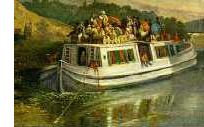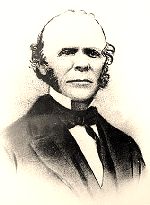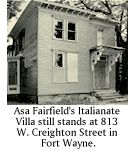  An old cannon confiscated from the British in the War of 1812, sounded the arrival
of Senator Cass at 6.00 a.m. Cass, principal orator for the day, arrived in a gaily
decorated canal boat from Toledo. Former Governor of Michigan and a seeker of the
Democratic Party's nomination for United States President, Cass arose to acknowledge the
generous applause given him by the crowd. Stepping on the gangplank to disembark from the
craft, he tripped and fell in the canal. Exhuming himself from the waterway, Cass retired
to the home of Allen Hamilton for dry attire befitting the occasion. An old cannon confiscated from the British in the War of 1812, sounded the arrival
of Senator Cass at 6.00 a.m. Cass, principal orator for the day, arrived in a gaily
decorated canal boat from Toledo. Former Governor of Michigan and a seeker of the
Democratic Party's nomination for United States President, Cass arose to acknowledge the
generous applause given him by the crowd. Stepping on the gangplank to disembark from the
craft, he tripped and fell in the canal. Exhuming himself from the waterway, Cass retired
to the home of Allen Hamilton for dry attire befitting the occasion.
The Miami, Wabash,
and Erie Canal Country. Harry G. Black 1991

 On the 2nd three boats left this place (Fort Wayne)
for Huntington for the purpose of bringing up such citizens of the lower end of the line
as might wish to attend the celebration. The arrival of these boats in Huntington was
hailed with the liveliest demonstrations of joy. On the 2nd three boats left this place (Fort Wayne)
for Huntington for the purpose of bringing up such citizens of the lower end of the line
as might wish to attend the celebration. The arrival of these boats in Huntington was
hailed with the liveliest demonstrations of joy.

The next day the boats returned to
Fort Wayne, and were met and saluted by a detachment of militia, under the command of
Capt. Rudisil; the salutes were returned by Capt. Fate's artillery, who came from
Huntington with the boats. On the morning of the 4th a procession was formed in front of
the Washington Hall and proceeded to the canal, where they embarked on the boats prepared
for the occasion, and took a trip to the feeder dam, seven miles distant. No less than 500
individuals, including a large portion of the fair sex, were present on the occasion.
Indianapolis
Indiana Journal. July 31, 1835

 The work was completed, and water let into the canal to the upper lock at
Huntington, then known as Burk's lock (its ruins may yet be seen opposite the residence of
John Mishler in the Second ward) on July 3d, 1835. The event was the occasion of an
enthusiastic meeting of the citizens. Tha canal boat "Indiana" had come down
from Fort Wayne with the waters, having on board a large number of the citizens of Fort
Wayne, who were greetd on their arrival, by the people, with loud cheers and salutes from
a cannon which Dr. George Fate had brough across the country from Dayton, Ohio, wxpressly
for the occasion. The Fort Wayne guests were given the hospitality of the citizens of
Huntington, and early in the morning, the fourth, returned to Fort Wayne, accompanied by a
large number of Huntingtonians and Doctor Fate's cannon, and celebrated the completion of
the canal between the two places and the glorious fourth in a manner long remembered by
participants. The work was completed, and water let into the canal to the upper lock at
Huntington, then known as Burk's lock (its ruins may yet be seen opposite the residence of
John Mishler in the Second ward) on July 3d, 1835. The event was the occasion of an
enthusiastic meeting of the citizens. Tha canal boat "Indiana" had come down
from Fort Wayne with the waters, having on board a large number of the citizens of Fort
Wayne, who were greetd on their arrival, by the people, with loud cheers and salutes from
a cannon which Dr. George Fate had brough across the country from Dayton, Ohio, wxpressly
for the occasion. The Fort Wayne guests were given the hospitality of the citizens of
Huntington, and early in the morning, the fourth, returned to Fort Wayne, accompanied by a
large number of Huntingtonians and Doctor Fate's cannon, and celebrated the completion of
the canal between the two places and the glorious fourth in a manner long remembered by
participants.
History of Huntington
County, 1887. Page 406

  My father (Asa Fairfield) had the first boat built - the passenger and freight
boat that ran on the canal - and it ws called the "Indiana." I remember they
went to Huntington to celebrate the fourth of July. Among the crowd were Hugh McCulloch,
my father's brother, my father, who was captain of the boat for that occasion, Allen
Hamilton, Judge Hanna, Major Lewis and a dozen or so of the early settlers. My father (Asa Fairfield) had the first boat built - the passenger and freight
boat that ran on the canal - and it ws called the "Indiana." I remember they
went to Huntington to celebrate the fourth of July. Among the crowd were Hugh McCulloch,
my father's brother, my father, who was captain of the boat for that occasion, Allen
Hamilton, Judge Hanna, Major Lewis and a dozen or so of the early settlers.
Reminiscences of
Old Fort Wayne, 1906 - Cyrus Fairfield remembers.
 Asa Fairfield came to Fort
Wayne a wealthy man, having gained his fortune during his travels as a sea captain. He
became known as one of Fort Wayne's founding fathers through his early investments in a
number of local businesses. Asa Fairfield came to Fort
Wayne a wealthy man, having gained his fortune during his travels as a sea captain. He
became known as one of Fort Wayne's founding fathers through his early investments in a
number of local businesses.
In a 1916 interview, his son Cyrus Fairfield said: "My father brought more money to
Fort Wayne than any man who preceded him. He was an old sea captain and had with him
$30,000. Mrs Thompson (formerly Ann R. Scott), the wife of Dr. L. G. Thompson, told him
several times he ought to be careful about the money, so he gave it to her for
safekeeping. She sewed the money in one of her mattresses, where she kept it until my
father could look around to see where he could best invest it."
 Asa established a
large farm south of Fort Wayne with the purchase of 240 acres at $12 an acre. He raised
hogs, sheep, and garden crops and invested in a number of local enterprises including a
soap and candle factory. He also bought the first grist mill (established in 1827 by
Samuel Hanna and James Barnett), and served as one of the first directors of the Fort
Wayne Branch of the State Bank of Indiana..... Asa established a
large farm south of Fort Wayne with the purchase of 240 acres at $12 an acre. He raised
hogs, sheep, and garden crops and invested in a number of local enterprises including a
soap and candle factory. He also bought the first grist mill (established in 1827 by
Samuel Hanna and James Barnett), and served as one of the first directors of the Fort
Wayne Branch of the State Bank of Indiana.....
....In 1868, Asa Fairfield died at his two-story house located near the section of the
city called South Wayne. He represented an 18th-century man who experienced life as a sea
captain, war hero, frontier settler and businessman and founding, father of Fort Wayne.
Allen County Fort Wayne
Historical Society newsletter - Summer 1998
 Yes, I went up to Fort Wayne and back on the first packet. It was on the 3rd of
July, 1835, and we returned next day on the 4th. There were about 25 of us in the party,
and that took pretty near the whole town, for it was very small in those days. Some of the
passengers were MR. and Mrs. Murray, Dr. Merrill and wife, Mr. and Mrs. Johnson, Mr. Burk,
Mr. Barker, Dr. Geo Fate and others. They have all been gone many years. Some of them died
fifty years ago. Yes, I went up to Fort Wayne and back on the first packet. It was on the 3rd of
July, 1835, and we returned next day on the 4th. There were about 25 of us in the party,
and that took pretty near the whole town, for it was very small in those days. Some of the
passengers were MR. and Mrs. Murray, Dr. Merrill and wife, Mr. and Mrs. Johnson, Mr. Burk,
Mr. Barker, Dr. Geo Fate and others. They have all been gone many years. Some of them died
fifty years ago.

The only sights along
the way were the wilderness woods, prairies covered with water, and in places there were
wolves, deer and Indians. I remember we stopped at the Vermilyea hotel for dinner. They
changed horses there.
At Fort Wayne a
public dinner was given next day and a grand time was had by all. We had no music on
board. Music was scarce in those times but there was a great deal of fun kept up, going
and coming. Dr. Fate shot a cannon off every few miles. He owned a cannon and took it
along. One time he slipped it into a house where there was a wedding and fired it off just
as the wedding ceremony was over. He was a strange man and kept a store down towards
Lafontaine street."
Huntington Herald,
Jan. 3, 1896 "Grandmother Hawley rode in it 60 years ago."

 Dr. George Fate, Huntington's second retail merchant with a store on West Market
street. Dr. George Fate, Huntington's second retail merchant with a store on West Market
street.
Historical
Pictures of Huntington County. Huntington Alert Inc. 1988

 Population and resources had greatly increased, having jumped from about
seventy-five thousand in 1820 and then more than doubled during the twenties to reach
about three hundred forty-three thousand in 1830. By 1840, the population totaled over six
hundred eighty-three thousand. Population and resources had greatly increased, having jumped from about
seventy-five thousand in 1820 and then more than doubled during the twenties to reach
about three hundred forty-three thousand in 1830. By 1840, the population totaled over six
hundred eighty-three thousand.
The Hoosier State
- Readings in Indiana History. Ralph Gray. 1980

 The canal in building was from 1832 to 1853, a period of 21 years; and in
operation from 1833 to 1874, a period of 41 years. From the date of the first grant of
land until the close of the canal, the population grew from a quarter of a million of
people, to one and three quarters." The canal in building was from 1832 to 1853, a period of 21 years; and in
operation from 1833 to 1874, a period of 41 years. From the date of the first grant of
land until the close of the canal, the population grew from a quarter of a million of
people, to one and three quarters."
History of the
Wabash and Valley. Stuart. 1924. p 56

 The result was that the first sections (of the W&E) completed were a valuable
aid to westbound immigrants. When the canal was begun in 1832 Indiana had probably a
little more than 350,000 inhabitants. By 1840 she had 684,000 and in 1850, 988,000. The
Indiana counties bordering on the section of the canal opened in 1835 had at that time
12,000 inhabitants; in 1850 they had 150,000. In the three years following of the first
section from Fort Wayne to Huntington, five new counties were created along the route.
Many people in Southern Indiana moved up to the northern part of the state, attracted by
the boom created by the canal. The result was that the first sections (of the W&E) completed were a valuable
aid to westbound immigrants. When the canal was begun in 1832 Indiana had probably a
little more than 350,000 inhabitants. By 1840 she had 684,000 and in 1850, 988,000. The
Indiana counties bordering on the section of the canal opened in 1835 had at that time
12,000 inhabitants; in 1850 they had 150,000. In the three years following of the first
section from Fort Wayne to Huntington, five new counties were created along the route.
Many people in Southern Indiana moved up to the northern part of the state, attracted by
the boom created by the canal.
Old Towpaths.
Alvin F, Harlow 1926 D. Appleton Co.

 As soon as the canal was put in operation, many took passage at Cincinnati or
Toledo for some point along the canal. Many of these people were a progressive and liberty
loving people, and educated and Christian people, and came here, and established homes,
and developed the country, thus the whole Wabash country was changed from one of heavy
forests and jungles, with great numbers of wild animals, and bands of roving Indians, to a
well-improved and prosperous country/ They built homes, schools, churches, towns, and were
engaged in all kinds of manufacturing, and have built various kinds of lines of
transportation. As soon as the canal was put in operation, many took passage at Cincinnati or
Toledo for some point along the canal. Many of these people were a progressive and liberty
loving people, and educated and Christian people, and came here, and established homes,
and developed the country, thus the whole Wabash country was changed from one of heavy
forests and jungles, with great numbers of wild animals, and bands of roving Indians, to a
well-improved and prosperous country/ They built homes, schools, churches, towns, and were
engaged in all kinds of manufacturing, and have built various kinds of lines of
transportation.

The Wabash and Erie
laid the basis for our present standard of citizenship, not only on the Wabash, but for
the whole state of Indiana. Before the canal, much of the business was done by barter, and
the people lived within themselves, but it brought about a revolution in business and
business methods. Business methods were changed from one of barter to a money basis. It
brought a reverse of trade for forty miles or more, on both sides of the canal. Along the
canal towns, all kinds of manufacturing plants were built up; large stores and warehouses
were erected, and printed on them were "Cash for Wheat;" "Cash for Wool and
Hides;" "Cash for Produce, Dry goods, Boots and Shoes, Hats and Caps." Some
people were loath to believe that the time had arrived for them to receive cash for the
produce of their farm.

 During the operation of the canal, many made fortunes, and on its closing many of
them were lost. During the operation of the canal, many made fortunes, and on its closing many of
them were lost.
History of the
Wabash and Valley. Stuart. 1924. p 56

 The canal boat stage did not last long in Indiana; but while it flourished, the
foundations of our present splendid prosperity were laid. The new State Constitution, the
school law, and the building of a system of railroads all came during that period. The canal boat stage did not last long in Indiana; but while it flourished, the
foundations of our present splendid prosperity were laid. The new State Constitution, the
school law, and the building of a system of railroads all came during that period.
Stories of
Indiana. Thompson. p217

|